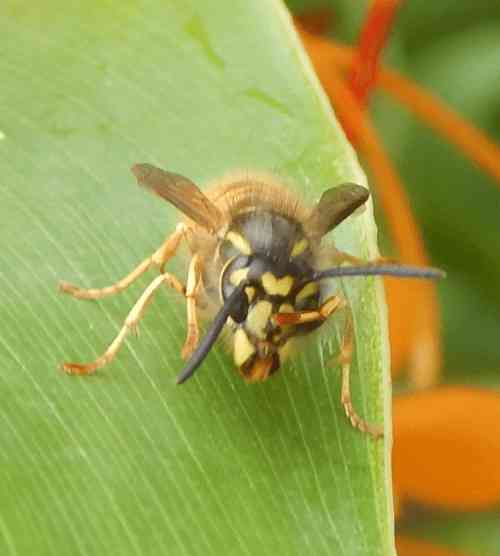Wasp Nests - Identification And What To Do About Them
Updated: September 2025
It's true that wasp nests are not usually welcomed by humans, but it has to be said that on balance, wasps are very beneficial insects both as pollinators (whose role is probably not fully understood), and as natural 'pest control', because they can help keep down populations of crop eating ‘pests’. Some farmers are harnessing the humble wasp for this very purpose!
In fact, as with bees, there are actually thousands of wasp species, and most are solitary and are pretty harmless, although if disturbed, some species can deliver a pretty painful sting.
The type of wasp people are mostly concerned about, are the black and yellow social wasps (especially those referred to in some regions as 'yellowjackets'), which may be attracted to sweet drinks, and can form large colonies.
But anyway, here's more information about wasp nests of the type that usually cause the most concern, including how to deter them from building a nest where they are not wanted.
What Do Social Wasp Nests Look Like?
Wasp nest identification
Some of the pictures on this page were sent to me by readers sharing their experiences.
These social wasp nests, are actually sophisticated structures and architectural masterpieces, comparable with the honeycombs made by honey bees! Often they are seen in shades of grey, with hints of green or brown.
For further information, see the early stages of a wasp nest, and watch a video of a wasp making a nest.
Of those wasps that build their own nests, the size of the structure and materials used may vary depending on factors such as the species and country or region.
Nests could occur in the ground and invisible unless exposed, or they can be seen hanging from tree branches, eaves of buildings or other supports as aerial nests, again depending on species.
Aerial wasp nests are typically greyish, greyish-green, or straw colored in appearance.
Below is an excellent image by Kaitlyn from upstate New York. This nest was made by a social species. Kaitlyn took several images and was keen to allow the nest to thrive. Thank you Kaitlyn! Note the shape - it becomes elongated toward the bottom. You can read more about this on my page: How do wasps build nests in trees?
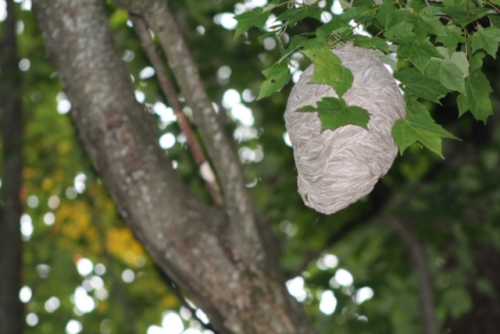 Wasp nest - photo sent in by Kaitlyn from upstate New York
Wasp nest - photo sent in by Kaitlyn from upstate New YorkThis nest below was also made by a social wasp species and was 'lodged' inside a shrub. The picture was taken in the UK.
As you can see, this
nest has a papery appearance, as if there are leaves of grey paper stuck
together in an overlapping fashion to form a kind of spherical ball shape, different from the nest above.
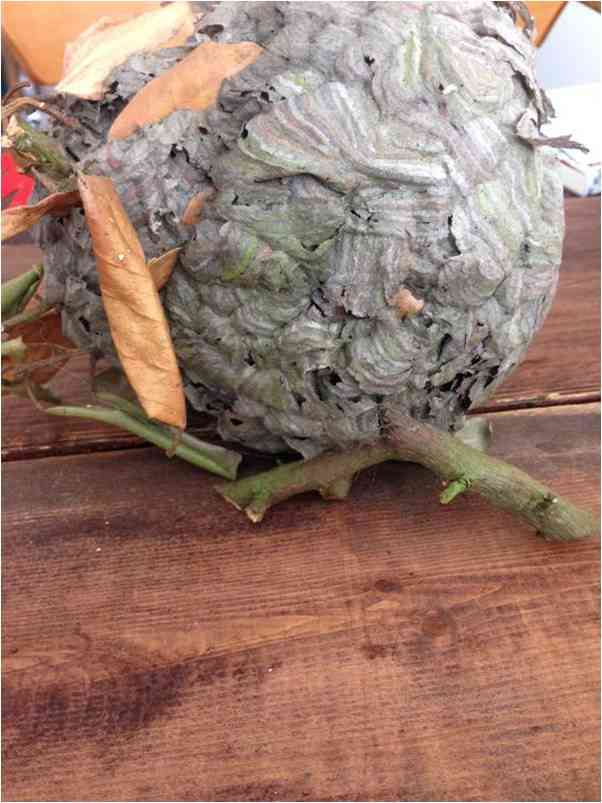 Above: Wasp nest found in a garden shrub - my thanks to Kelly Pinnick for permission to use this image
Above: Wasp nest found in a garden shrub - my thanks to Kelly Pinnick for permission to use this imageHow long do social wasp nests last?
Most wasp colonies only last a season. As with bumble bees, only the queens survive to establish future colonies and the rest of the colony dies. In warm weather, and in some geographical regions, a colony may thrive for longer.
Nests are only used once. Indeed, it is for this reason that if you wish to deter wasps building a nest in the same place the following year, it is advisable to leave at least part of the nest structure in place once the nest has been abandoned.
The reason for this is that social wasps are territorial and typically avoid founding new colonies close to other nests. In actual fact, some wasp deterrents use this principle to advantage, by creating a 'dummy' nest to dissuade queens from starting colonies nearby. You can read more about this below.
Inside a social wasp nest
These photographs below show a little of the inside of the social wasp
nest pictured above.
You can see the structure is composed of neat, hexagonal shaped cells - (just like comb made by honey bees) in which the young are reared. The hexagonal cell structure is a super efficient way to use space and fit compartments together, whilst using the minimum amount of materials (and hence resources). Wasp nests are actually amazing!
See: bee hive vs wasp nest.
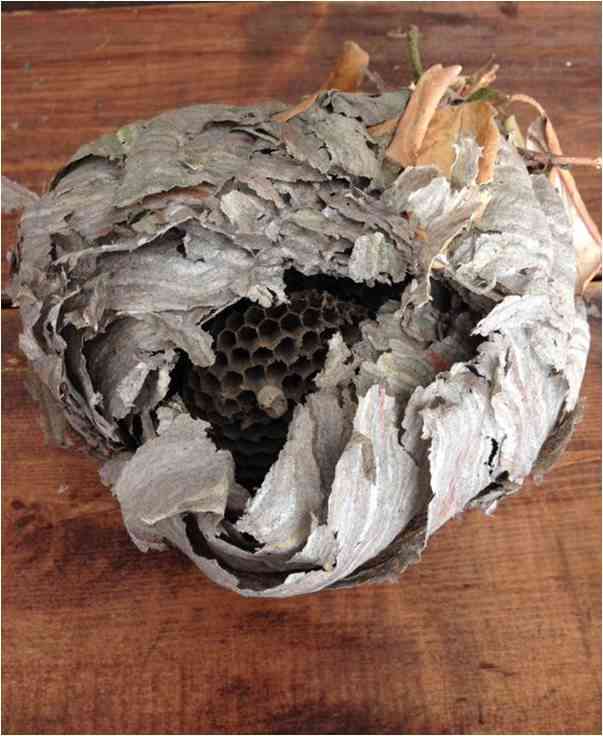 Wasps are magnificent architects! - Photo by Kelly Pinnick
Wasps are magnificent architects! - Photo by Kelly Pinnick
The cells are constructed by using thin scrapings of plant matter or wood. The wasp mixes the fine scrapings of wood with the saliva in her mouth. This breaks down the fibres into a pulp which is then used for constructing the cells. It's a little like the craft of paper making!
In fact, it is thought that wasps inspired the invention of paper around 2,000 years ago! You could even say that wasps invented it, humans copied it. When we realize just how amazing wasps are, we can appreciate them more! See more facts about wasps.
Signs of wasp activity
Given that some wasps may gather fine shavings of wood to build their nests, you may see signs of wasp activity in the form of tiny scratches on wooden fences and garden furniture.
One year, wasps were collecting material from our garden fencing to construct a nest in ivy growing up an old tree in our neighbour's garden. If you look closely, you can see the pale, vertical marks on the wood, resembling scratches.
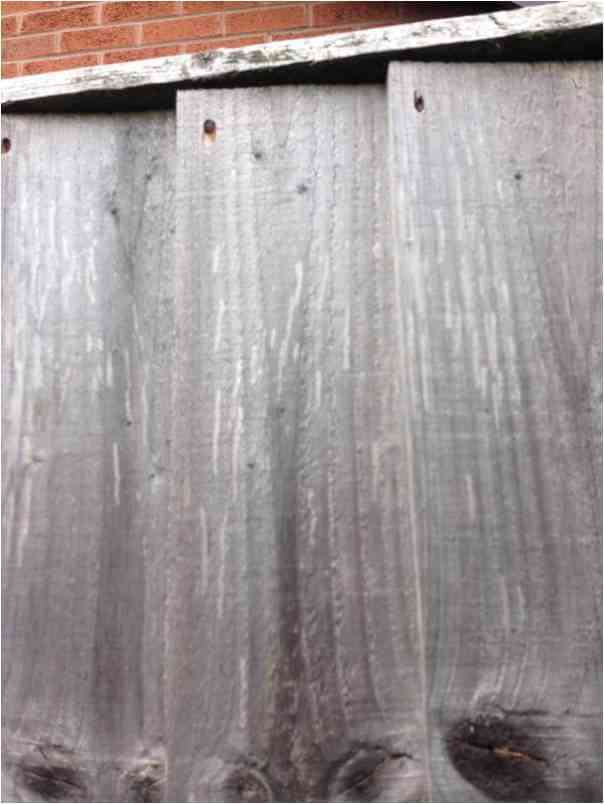 Above: If you look very closely, there are pale white, vertical scratches on this old piece of wooden fencing. Wasps have been gathering material with which to create pulp for constructing their nests.
Above: If you look very closely, there are pale white, vertical scratches on this old piece of wooden fencing. Wasps have been gathering material with which to create pulp for constructing their nests.Where do social wasps build their nests?
Aerial nests can be concealed by leaves and cavity nests can be out of site, but on buildings, or inside man-made cavities, they are sometimes easy to spot.
Wasp nest on eaves of a house, apartment, other building or deck overhang
I received a wonderful email and photograph from Kellie in Canada, of a lovely paper wasp nest:
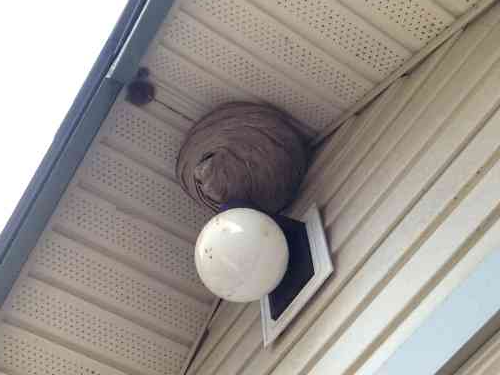 Above: Social wasp nest on Kellie's deck overhang. She chose to leave it alone.
Above: Social wasp nest on Kellie's deck overhang. She chose to leave it alone."I came here to learn more about a wasp nest that was getting larger on my apartment's deck overhang.
As I have 2 decks, I chose to leave the nest alone. As the nest grew, I found that the wasps were not aggressive when I went out to water the planter boxes on the deck, and noticed them taking advantage of the water and flowers.
I have a new appreciation for wasps and wanted to thank you for your helpful information".
I'm so glad Kellie found the information on this website helpful. I genuinely think that a lot of the beliefs we have about such things (like wasps) are handed down and taken for granted. When we try and take a step back and be open to the idea that things might be different, we can get a pleasant surprise!
However, if you wish to prevent wasps building nests in such locations, you can do so without killing them. I recommend using a Waspinator - they are not too expensive, and further information is provided below. I especially recommend installing a Waspinator around schools and public buildings.
In a cavity
A cavity could be underground, in a building, or even....inside a barbecue, as was the case here. Such nests typically belong to the yellow jacket kind. I'm very grateful to Deborah Hammond from the USA, for sending me these pictures of the nest inside her barbecue, and for allowing me to use them.
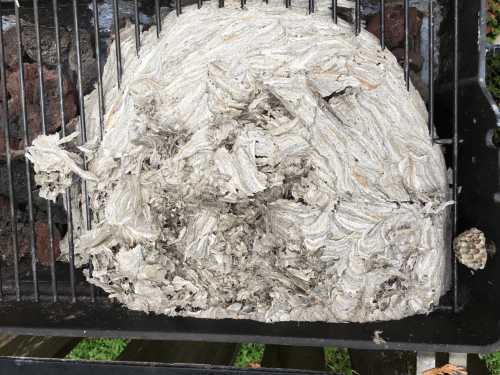 The top of the wasp nest inside the barbecue.
The top of the wasp nest inside the barbecue.Photo by Deborah Hammond.
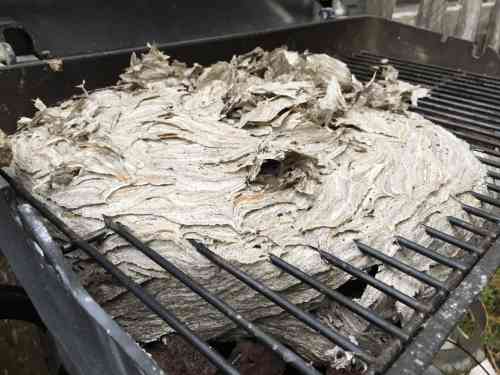 Here you get a better view of the structure from the side. They are apparently using the bars to support the nest structure.
Here you get a better view of the structure from the side. They are apparently using the bars to support the nest structure.Photo by Deborah Hammond.
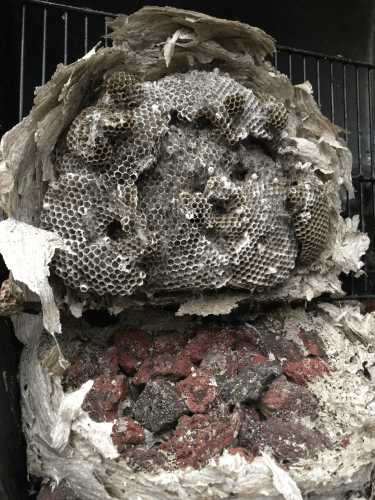 Inside the wasp nest, the amazing architecture exposed.
Inside the wasp nest, the amazing architecture exposed.Photo by Deborah Hammond.
Deborah said:
"They particularly loved my red dahlias. I worked in the garden all summer and was not bothered. It made my visitors nervous, but I agree with you about simply maintaining calm...…Wait, I did get stung once when I wrapped my hand around a tool handle, not realizing there was a wasp on it. Hurt like a mama!"
Ouch! I'm impressed that Deborah remained so tolerant of the wasps after this accident, and didn't mind putting her hand close to the abandoned nest later - the image below helps provide an idea of the size of the nest.
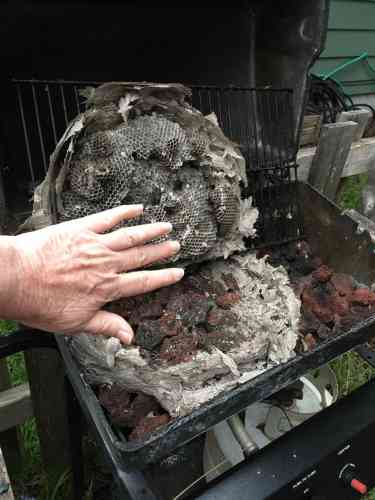 Deborah's hand by the abandoned nest helps to provide some idea of scale.
Deborah's hand by the abandoned nest helps to provide some idea of scale.Photo by Deborah Hammond.
Deborah took fantastic photographs, and I especially like the one below - a close up photograph of those amazing nest cells.
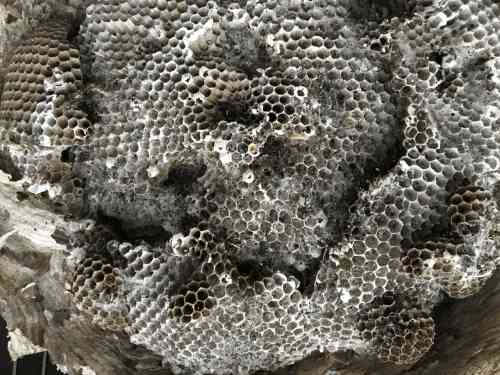 Amazing hexagonal nest cells, intricately constructed from tiny shavings of wood.
Amazing hexagonal nest cells, intricately constructed from tiny shavings of wood.Photo by Deborah Hammond.
Wasp nest in the shed or garage
Nests are commonly found in sheds and garages, and
this photograph below provides a clear image of a nice smooth looking wasp nest in
its entirety, that was found in a shed.
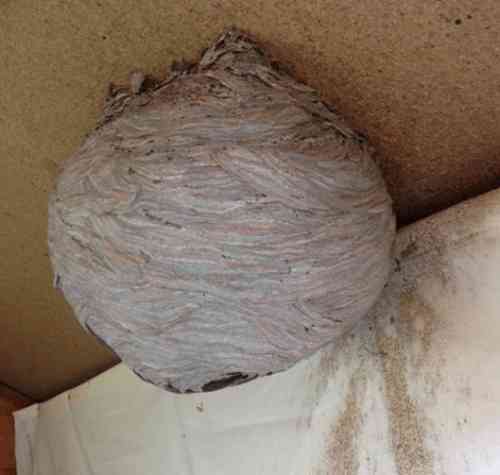
Wasp nests in chimneys
Another favourite place is the chimney cavity – my sister had
such a scenario, and asked me what I thought she should do.
Taking into account that the nest was basically paper, and could be a potential fire hazard, I advised her against lighting a fire in order to 'smoke the wasps out'. Anyway, this could have backfired and made the wasps very angry!
Fortunately my sister was not using that particular room. She simply kept the door closed to keep the wasps out of the rest of the house. Later in the year, when the wasps were no longer active, she removed the nest from the chimney, and got the vacuum cleaner out to clear away any dead wasps left behind in the room.
Wasp nest in a bird house
I received a wonderful email from a lady in Somerset, England, UK.
She wrote:
"I would like to send you a photo of the wasp which is nesting in the old bird house on my kitchen wall. They are median wasps and the nest is 'clothed with smooth grey sheets' just as it says in my insect guide book. I think you will enjoy seeing it. Very unusual - at least for me."
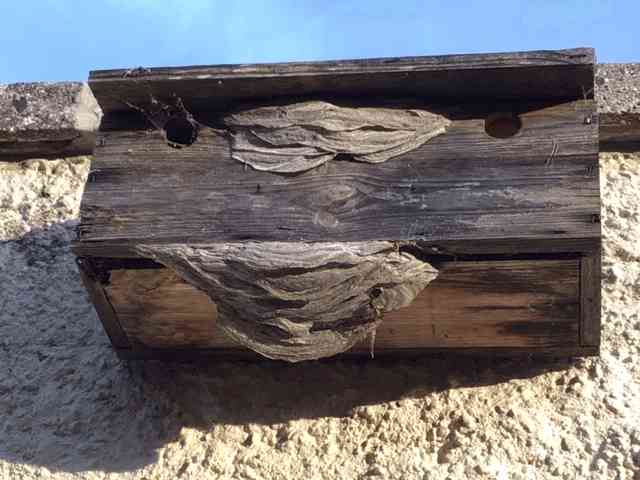 Above: Nest of the Median wasp Dolichovespula media in an old bird house.
Above: Nest of the Median wasp Dolichovespula media in an old bird house.These images are great because you can see how the layers have been created, and how this opportunistic wasp appears to have made good use of the bird box, just as a bumble bee colony might, or honey bees use a human-made bee hive.
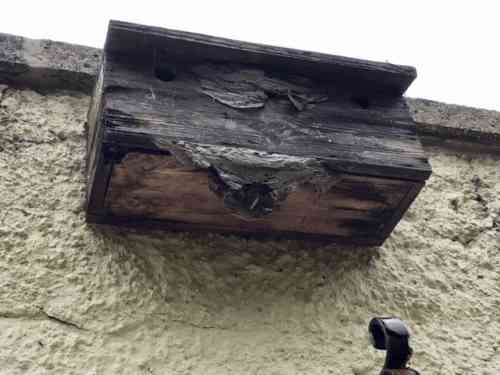 Above: Within a few weeks, the nest is no longer active, and is beginning to look a little ragged.
Above: Within a few weeks, the nest is no longer active, and is beginning to look a little ragged.Wasp nest in the compost heap
For a couple of years, we had a nest in our compost bin that was close to the back door of the house. There were wasps going in and out all the
time. I am especially tolerant, however,
and didn’t worry, I
simply stopped using the composter for some months. Fortunately we were not stung.
Later, we dismantled the compost bin, and moved it to another area of the garden. The wasps did not return. We then acquired a larger compost bin, and bumble bees moved in, and successfully reared workers, males and new queens :).
Wasp nests in the loft or attic
Another common place to see wasp nests, and sometimes an occasional hibernating queen or two, is in the loft or attic.
We once had hibernating wasp queens in the attic, and we found a nest - already abandoned. I am quite protective, and never harm the queens.
Note:
Everyone's situation is different, and indeed, an especially large nest could cause alarm, especially where there are pets and young children. Stings can occur. If a removal is necessary, contact a professional.
Other types of wasp nest - social and solitary
Of course, not all members of the wasp family have the same nest architecture. For example, potter wasps (Eumeninae) and the mud wasps - Sphecidae (also called 'dauber wasps') use mud to build their nests.
Also, take a look at the amazing gall wasp!
Some wasps are parasitoids, and don't build nests at all, but instead, rely on a host species. See Types Of Wasp.
Educating the next generation about wasps
Please see my page about the structure of a social wasp nest. The lady who sent in the images could hardly wait to take the pieces of nest to a school for children to learn all about it!
I believe understanding helps to replace fear with respect.
I also recommend A Wasp Builds a Nest: See Inside a Paper Wasp's Nest and Watch It Grow by Kate Scarborough and Martin Camm.
Seek assistance if a nest is large and intolerable - take steps to repel or deter them in the future
If you discover a large nest and find this intolerable, you will have to call for professional help.
Keeping wasps out of the garden and away from the house or office block
You could try some natural means to repel wasps, or install a Waspinator.
They need to be put in place at the beginning of the season, before wasps arrive, otherwise they won't work.
A Waspinator looks like a wasp nest, thus deterring wasps from building a nest nearby, because - as stated earlier, wasps are territorial. You could have a go at making one, but on the other hand, they are not too expensive and should last some time.
You can get a Waspinator from Amazon. Or if you have suitable materials, you could make your own.
(Disclaimer: as an Amazon Associate I earn from qualifying purchases from links on my site - this won't affect the price to you, and helps me with the cost of running this site where I provide lots of free information. Because I would like to have a wasp nest in my garden, I have never tried this method, but have heard good reports when used correctly).
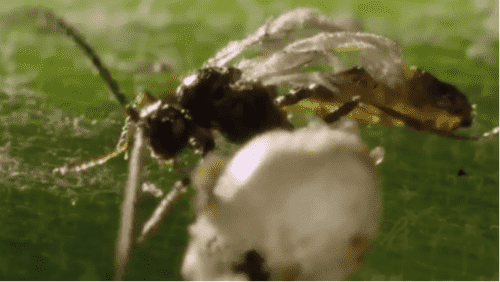
Body Snatcher Wasps!
Why are farmers turning to wasps to help them control crop eating pests?
If you found this page helpful or interesting, I'd really be grateful if you would share it with others - if not this page, perhaps another, such as Gardening For Bees.
Thank you so much :) .
